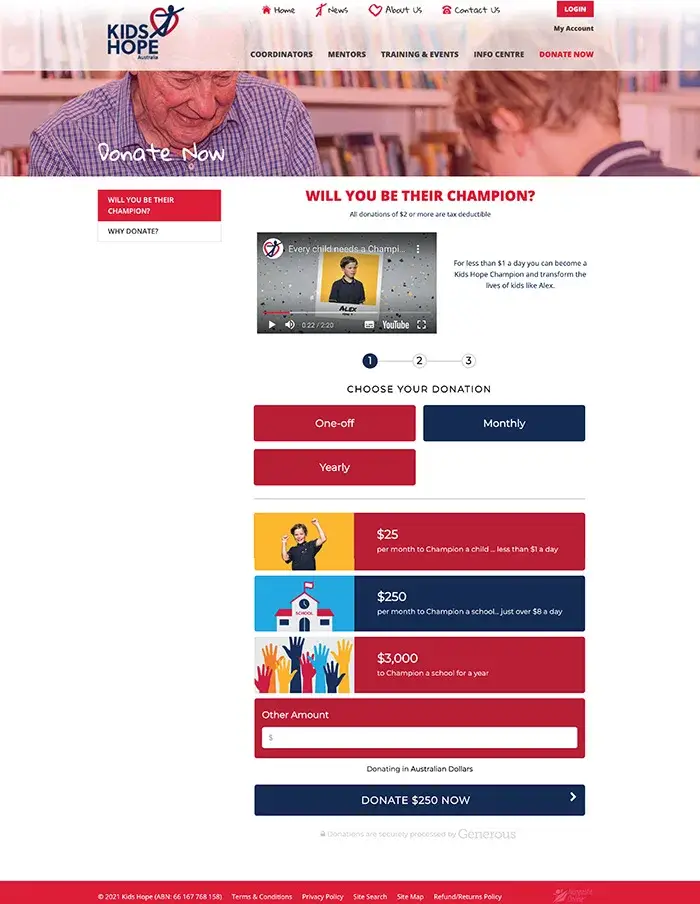In one of our previous blog entries, we discussed the fundamental elements of a nonprofit web page. But once you know what you must have on your digital front door, how can you make sure you are doing it correctly? Today we are going to go through best practices and not-to-be-missed approaches to make sure you have a top flight NFP website.
1. Strong web design
The web design includes all visual and copy elements as well as its layout. The design is one of the most important elements as it will help your users navigate through the page or drive them away. When developing your website certain aspects that may seem obvious are very often neglected, and you need to get them right:
Proper branding: Your colours, logos, name, font are your brand’s ID, and you need to get them right across your organisation. This may seem like an obvious statement but is critical to excel in it.
User experience design (UX): Your design must have in mind your end user, and how to give them the best experience. We all love when things are easy to use and intuitive and when at a glance we see the important information and what actions we can and want to perform. A good UX design will ensure your visitors enjoy the time they spend with you which makes them more likely to stay longer and come back for more.

Whitespace: One of the other things we sometimes overlook is the white space or negative space. We are talking about the empty space between elements on your page. As tempting as you may be to fill out all the spaces with content and information, it is important to respect it. It is a great tool to balance your design and help you organize elements to improve the visual experience.
Call to Action (CTA): Once you know which action you wish your audience to take you will need to develop a strong and appealing Call To Action. This element is used to make a direct request, whether it is to “Donate now”, to “Find out how to volunteer” or to “Contact us”. This element objective is to drive action, and therefore it is very important to be direct and clear. A strong CTA will get your visitors invested and it will directly contribute to the success of your page.
Audio-visual elements. Include engaging imagery, impactful images, close up shots, videos and animations. These elements will get your audience attention, so use them to direct them where you want them to be focused. It is important to bear in mind best practices: always use high-quality images that are not pixelated and make sure they are relevant to support your story.
2 . Keep in mind all devices
These days, most people use their mobile devices to browse information on the internet. A study from the Nonprofit Source website showed an increase of 205% of donations being made through a mobile phone. This means that if your website is not considering this device you are missing out on a significant portion of your audience .
Have a website that is responsive and adapts to other device formats to give a great experience, otherwise, navigating your NFP website will be difficult for mobile users, leading to frustration and causing them to leave.

3. SEO and Page speed
We consider SEO and page speed together because they both help your page rank higher and therefore be more likely to be seen. If terms like SEO, SEM and SERP sound like nonsense don’t panic! Mastering SEO is a whole craft, but there are some basics you can cover without needing much training.
Keywords: Start by identifying Keywords that the audience you are targeting may be looking for and use them on your website, use free tools like Keywords everywhere or wordstream. Or if you already have a google account use the Google Ad tool to get an idea of how the Keywords you are interested in are performing. Now that you know which keywords your audience is looking for, it is time to make sure they are included in your website on Headers and Headlines, as well as in the content.
Organic content: To help you rank organically on the browsers, use content related to the nature of your nonprofit, and what your audience is most interested in. Keep in mind the Keywords you have identified previously and some new ones you may want to be found for, and include them in your content. Blogs, landing pages and articles are a very successful way to include organic content in your web and boost your SEO ranking.

Speed: Although it may seem that is not related, this is critical. A very slow page will be ranked very low by Google, as it is not considered properly optimised, and it will not be found as relevant as others with a better loading speed.
4. A good design donation page
We already established the importance of having a donation space, and the better it is designed the more donations will drive. Having a detailed and specific donation page will increase your chances to get donations if used wisely.
Include visual proof of the use of those funds, provide information on why you need your supporters to help and put them in the centre of the request. But beyond visual and information appeal, the form must be easy to navigate. A simple form that is straightforward and does not require many steps will be more encouraging to start and finish a donation.
The simpler your process, the more they will appreciate it, and the more chances they may become regular donors!

5. Ensure Accessibility
You probably want as many people as possible to be able to visit and interact with your page right? Sometimes when we design a website we overlook the accessibility aspect of it and the different abilities people have and how this may affect the way they approach the navigation.
Having a web design that ensures accessibility talks about how people perceive, understand, navigate and interact with your site, referencing their abilities and disabilities to access the web. Some differences can be found in the auditory, cognitive, visual, physical and even psychological aspects of the interaction.
You can adhere to web content accessibility guidelines (WCAG) to make sure your website is accessible for people that otherwise may not be able to interact with you. Make sure you are leaving the door open for everyone and you are making it easy for them.
6 . Be updated!
Search, search and research. Spend some time just navigating through the ocean of amazing websites that are already created out there. Go to Pinterest and check out pin boards with web design layouts, hacks and visual recommendations. Visit blogs and Facebook pages, become a detective and investigate what is the trend. While doing so you will learn so much about what is working and what is not, and you will be able to go back to your website and identify those things you have mastered, and those that still need polishing.
You can also check out some of our recent designs to get some inspiration:
The Smith Family
Bears of hope
Orygen
CAP
Family life
Epilepsy foundation


